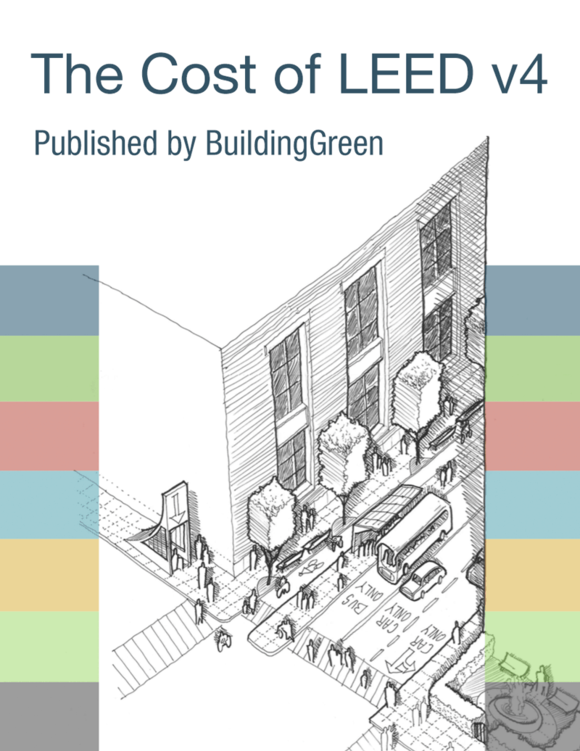Intent
To connect building occupants with the outdoors, reinforce circadian rhythms, and reduce the use of electrical lighting by introducing daylight into the space.
Requirements
Provide manual or automatic (with manual override) glare-control devices for all regularly occupied spaces.
AND
Select one of the following three options.
Option 1. Simulation: Spatial Daylight Autonomy and Annual Sunlight Exposure (1–3 points, 1-2 points Healthcare)
Perform annual computer simulations for spatial daylight autonomy300/50% (
sDA300/50%), and annual sunlight exposure1000,250 (
ASE1000,250) as defined in IES LM-83-12 for each regularly occupied space. Additionally, calculate the average
sDA300/50% value for the total regularly occupied floor area.
For any regularly occupied spaces with
ASE1000,250 greater than 10%, identify how the space is designed to address glare.
Points are awarded according to Table 1.
Table 1. Points for Option 1
|
The average sDA300/50% value for the
regularly occupied floor area is at least 40%
|
1 point
|
|
The average sDA300/50% value for the
regularly occupied floor area is at least 55%
|
2 points
|
|
The average sDA300/50% value for the
regularly occupied floor area is at least 75%
|
3 points
|
|
Each regularly occupied space achieves sDA300/50% value of at least 55%
|
Exemplary performance
or 1 additional point if 2 points
achieved above.
|
The
sDA and
ASE calculation grids should be no more than 2 feet (600 millimeters) square and laid out across the regularly occupied area at a work plane height of 30 inches (762 millimeters) above finished floor (unless otherwise defined). Use an hourly time-step analysis based on typical meteorological year data, or an equivalent, for the nearest available weather station.
Include any permanent interior obstructions and moveable furniture and partitions.
OR
Option 2. Simulation: Illuminance Calculations (1–3 points, 1-2 points
Healthcare)
Perform computer simulations for
illuminance at 9 a.m. and 3 p.m. on a clear-sky day at the equinox for each regularly occupied space.
Demonstrate
illuminance levels are between 300 lux and 3,000 lux at both 9 a.m. and 3 p.m. Spaces with view-preserving automatic (with manual override) glare-control devices may demonstrate compliance for only the minimum 300 lux
illuminance level.
Points are awarded according to Table 2.
Table 2. Points for Option 2
|
Percentage of regularly occupied floor area
|
Points
|
|
55%
|
1
|
|
75%
|
2
|
|
90%
|
3
|
Calculate
illuminance intensity for sun (direct component) and sky (diffuse component) for clear-sky conditions as follows:
- Use typical meteorological year data, or an equivalent, for the nearest available weather station.
- Select one day within 15 days of September 21 and one day within 15 days of March 21 that represent the clearest sky condition.
- Use the average of the hourly value for the two selected days.
Exclude blinds or shades from the model.
Include any permanent interior obstructions and moveable furniture and partitions.
OR
Option 3. Measurement (1-3 points, 1-2 points Healthcare)
Measure
illuminance in each regularly occupied space.
Achieve
illuminance levels between 300 lux and 3,000 lux. Spaces with view-preserving automatic (with manual override) glare-control devices may demonstrate compliance for only the minimum 300 lux
illuminance level.
Points are awarded according to Table 3.
Table 3. Points for Option 3
|
Percentage of regularly occupied floor area
|
Points
|
|
55% at one time in the year
|
1
|
|
75% at two times in the year
|
2
|
|
90% at two times in the year
|
3
|
With furniture, fixtures, and equipment in place, measure
illuminance levels as follows:
- Measure at appropriate work plane height during any hour between 9 a.m. and 3 p.m.
- If pursuing one point, take one measurement in any regularly occupied month. If pursuing two points, take two measurements: one measurement in any regularly occupied month, and take a second as indicated in Table 4.
- For spaces larger than 150 square feet (14 square meters), take measurements on a maximum 10 foot (3 meter) square grid.
- For spaces 150 square feet (14 square meters) or smaller, take measurements on a maximum 3 foot (900 millimeters) square grid.
Table 4. Timing of measurements for illuminance
|
If first measurement is taken in …
|
take second measurement in …
|
|
January
|
May-September
|
|
February
|
June-October
|
|
March
|
June-July, November-December
|
|
April
|
August-December
|
|
May
|
September-January
|
|
June
|
October-February
|
|
July
|
November-March
|
|
August
|
December-April
|
|
September
|
December-January, May-June
|
|
October
|
February-June
|
|
November
|
March-July
|
|
December
|
April-August
|



